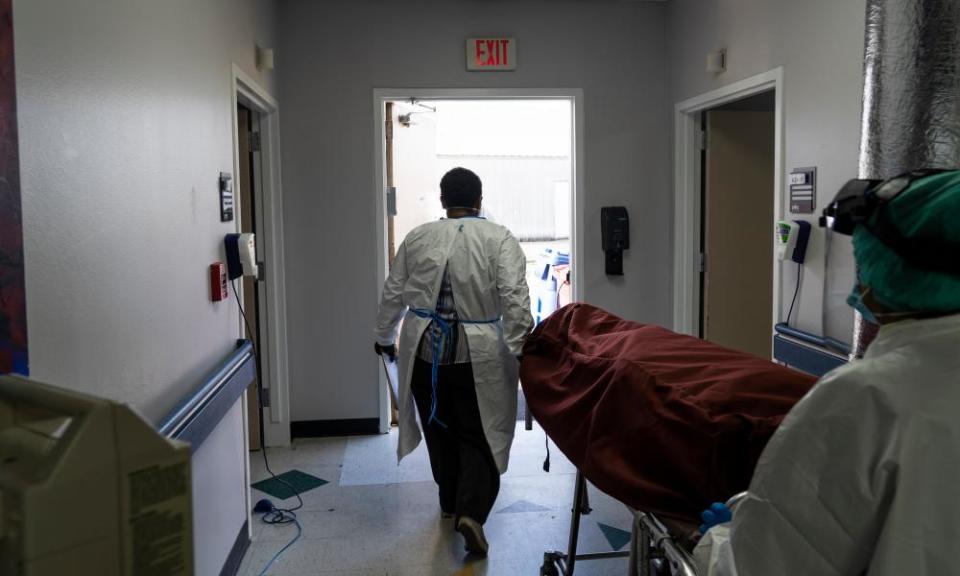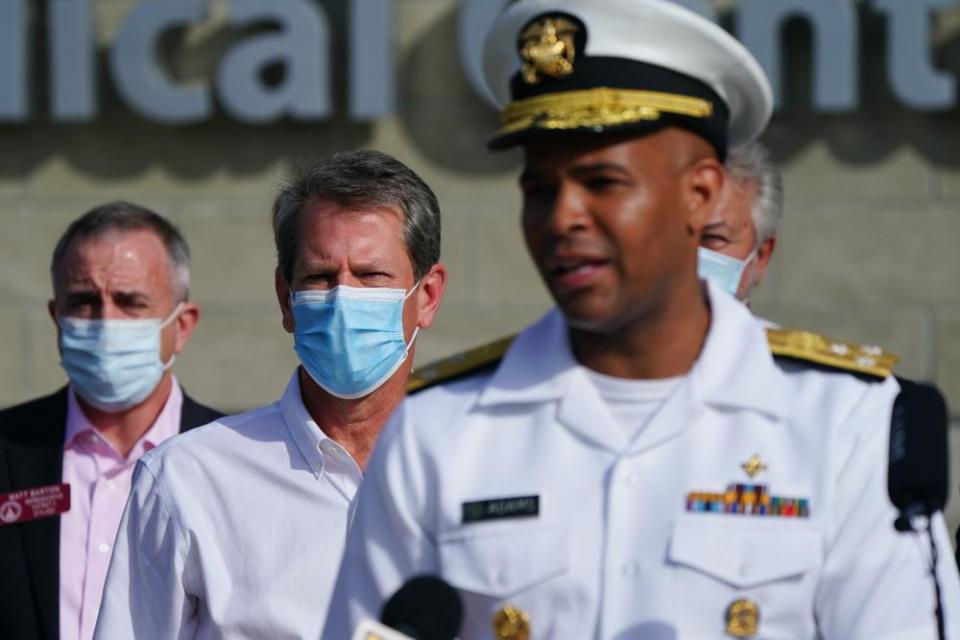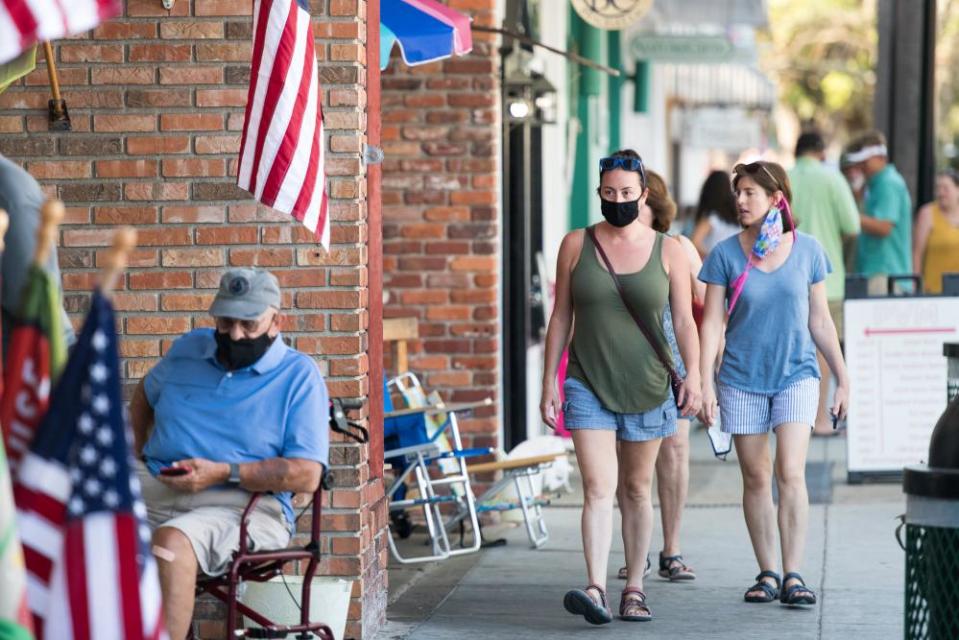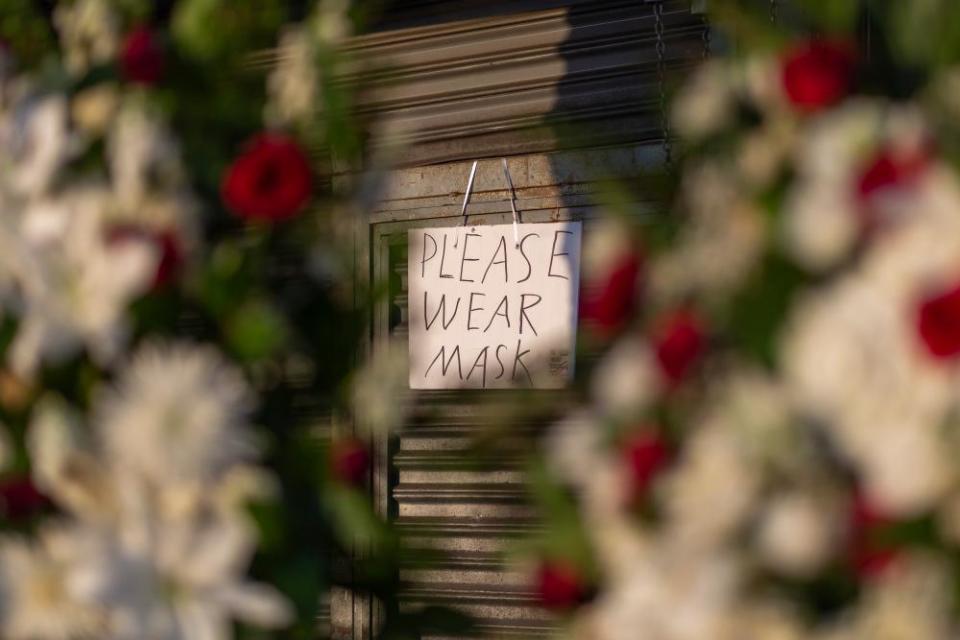'We're making it up as we go along': how Trump's America failed the Covid test

A letter landed on the desk of the governor of Georgia, Brian Kemp, this week that given the public health catastrophe swirling all around him might give him pause. His state is one of 21 across the US that have been placed by the White House coronavirus taskforce in the “red zone”, indicating the disease is now so prevalent that immediate restrictions must be imposed to avoid dire consequences.
Kemp, a Republican governor and Donald Trump ally, has adopted a controversial approach to Covid-19. Since early July the virus has roared across his state, with new infections rising sharply to top a devastating tally of 182,000.
Deaths too have ticked dramatically upwards, with new daily peaks pushing the toll close to 4,000. Yet Kemp continues to expend much of his political energy fighting local officials rather than the microbe.
For weeks he has been suing the Democratic mayor of the largest city, Atlanta, to stop her mandating masks. Keisha Lance Bottoms, who is African American, as is more than half of her city, has decried the move by Kemp, who is white, as an act of “personal retaliation”.

Videos are circulating of unmasked nightclubbers grinding in close proximity in packed dance floors. Yet Kemp continues to allow clubs, bars and indoor restaurants to carry on with abandon.
Social media images show high school corridors crammed with non-mask-wearing pupils on the first day of the new school year. Yet Kemp persists on passing the buck on whether to open classrooms to individual school districts. In Atlanta alone, 260 staff tested positive for the virus, or exposure to it, even before classes began.
It is against this backdrop that the letter dropped on Kemp’s desk. Signed by almost 2,400 doctors, nurses, physical therapists and other public health workers at the coalface of the pandemic response, it paints a devastating picture of mortally ill people stretching hospitals to breaking point right across the state under Kemp’s watch.
Our situation is rapidly getting out of control
Melanie Thompson
The letter pleads with Kemp to change tack, calling on him to enforce a temporary mask order, close bars and nightclubs and heavily restrict indoor dining and gatherings at places of worship. The signatories entreat him to rapidly expand testing to counter huge lines and speed up test results which can take two weeks.
“Our situation is rapidly getting out of control,” Melanie Thompson, an Atlanta physician and co-organizer of the letter, told the Guardian. “Frontline health workers are at the end of their ropes – we have been left on our own to make it up as we go along, while the governor fails to do what’s needed to control this epidemic.”
But Georgia is far from unique.
Seven months into the pandemic, the full horror of a deadly disease allowed to run amok by state governors and a US president who has consistently downplayed the severity of the crisis, denied the science and deflected attention from the failures of his own administration is now glaringly evident. The virus has taken hold of the south and is making its way steadily up the Mississippi River into the heartlands of America.
As the virus spreads, the many discrete problems that it has exposed in earlier stages of the pandemic are now congealing into one epic challenge.

The Covid crisis in Georgia under Kemp is no longer a matter of inadequate testing or unworkable contact tracing; shortages of personal protective equipment (PPE); overflowing ICU beds; confusing public messaging; virulent misinformation and conspiracy theorizing; not to mention the culture war over masks or the grotesque racial disparities that ensure that 80% of hospitalized patients in the state are African American.
Georgia’s plight is not a matter of any one of those factors. It is a product of all of them.
Back in the spring, colleagues and I predicted that this virus was so insidious it would move into rural areas
Caitlin Rivers
The virus has extended its invisible tentacles out of the urban centers such as Atlanta and the second-largest city Augusta, through the suburbs and into rural areas where health services that were inadequate before the pandemic are now on their knees.
“This was foreseen,” said Caitlin Rivers, an epidemiologist at Johns Hopkins Center for Health Security. “Back in the spring, colleagues and I predicted that this virus was so insidious it would move into rural areas where it would be particularly pernicious and difficult to control.”
Like many of her fellow experts in pandemic response, Rivers has watched with growing dismay as the Trump administration and its governor outriders have missed multiple opportunities to contain the virus. “Humanity has gone to great lengths in the past to defeat infectious diseases – the eradication of smallpox for one,” she said. “I haven’t seen the same energy around this pandemic.”
As time passes, and the nationwide death toll mounts, Rivers observes that the landmarks are spaced ever wider apart. The country commemorated the first death, followed by the first 100 deaths, then 1,000, then 100,000, almost without noticing that the currency of death was being devalued along the way.

The same applies to the total number of confirmed infections in the US, now approaching 5m – more than a quarter of all recorded cases in the world. When Dr Anthony Fauci, the top US infectious diseases expert, said in March there would be “millions of cases” before the pandemic was done, America’s collective jaw dropped; but when the news broke recently that there were almost 2m new US cases in July alone, the nation barely blinked.
“I hear complacency and people accepting that this is how things are going to be,” Rivers said. “But it is never too late to take a different tack and steer the ship to somewhere better. We can do that now, we should do it now.”
Complacency sums up Trump’s helmsmanship as he sails directly into the eye of the storm. From the day that the first Covid case was recorded in the US on 20 January, the president has been slow to respond to the threat, has put his re-election hopes and reopening the economy ahead of public safety, and has repeatedly ignored scientific warnings in favor of his own fatally flawed instincts.
With the death toll at almost 160,000, Trump has sought refuge in the acceptance that Rivers identified. That tendency was on vivid display this week in the widely parsed Axios interview, in which it was put to Trump that 1,000 Americans were dying every day.
The US, relative to the resources we have, has had the worst response to the pandemic in the world
Abraar Karan
“They are dying. That’s true,” Trump replied. “It is what it is. But that doesn’t mean we aren’t doing everything we can. It’s under control as much as you can control it.”
Abraar Karan, a global health physician at Brigham & Women’s hospital and Harvard Medical School in Boston, scoffs at the idea that the US has done all it could. “The US, relative to the resources we have, has had the worst response to the pandemic in the world,” he said.
What riles Karan most is that political leaders have had the benefit of watching others go through the crisis, yet have stubbornly refused to learn the lessons. “China, South Korea, Japan and Italy – they were all hit before we were and we didn’t listen. Then the north-east was hit on our own soil and we didn’t pay attention. Now numbers are soaring in Texas, Arizona, Florida, and people still aren’t listening,” he said.

With the US registering about 55,000 new cases a day, the country looks destined to be punished by further repetitions for the foreseeable future. Epidemiologists at the University of Washington in Seattle suggest that under current projections as many as 230,000 Americans will have lost their lives by presidential election day on 3 November.
Average Americans are so insecure they no longer feel safe to leave their homes
Peter Hotez
By the end of this year the US could be well on its way towards 300,000 deaths.
“This has gone beyond a danger to the health of Americans, it is now a full-blown homeland security crisis,” said Peter Hotez, a global health scientist at the Baylor College of Medicine in Houston. “Average Americans are so insecure they no longer feel safe to leave their homes.”
Hopes that political leaders will change tack have faded for Hotez to such an extent that in the absence of federal guidance he has produced his own guidelines for how to contain the virus. He calls them his “October plan”, and notes that other academic centers of excellence have also started producing similar plans in a desperate attempt to fill the void. They include Caitlin Rivers and her colleagues at Johns Hopkins who have published a document titled Resetting Our Response: Changes Needed in the US.

Hotez worries too that people are being lured into false confidence by hopes for a vaccine, which he predicts will only arrive in the middle of 2021 at the earliest. He is similarly skeptical about the idea that were Joe Biden to win the presidential election in November things would change quickly, given that Biden would only enter the White House on 20 January.
It all points towards a period of drawn-out agony for America. Asked how the country will cope amid this seemingly never-ending tragedy, Hotez channels Winston Churchill.
“When you are going through hell, keep going,” he said. Then he added: “We have no other choice.”

